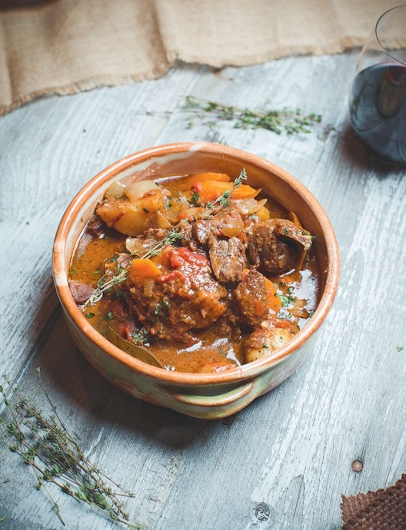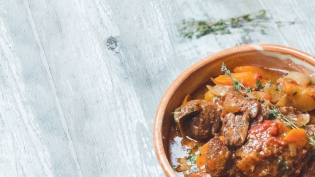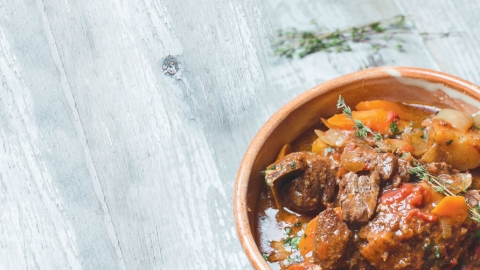A Guide To Eating Local: Goat Meat, a Culinary Adventure
Even though goat meat is a staple of many cultures, why are Americans so hesitant to jump on the bandwagon? Could it be that the word “goat” evokes an image of a scruffy scavenger chewing on a rusty tin can, or foraging through all manner of indigestible garbage?
Goats are reputed to be one of the earliest domesticated animals. Today, they provide the principle source of meat for many Caribbean, Southeast Asian, North African and Middle Eastern countries. Most Americans are surprised to learn that three quarters of the world’s inhabitants eat goat meat as part of their daily diet.
In our country it has taken longer for goat meat to gain some degree of popularity. Demand has increased as a variety of ethnic groups have migrated to our shores. Goat meat is known as chevon in Northern Europe, capretto in Australia and Southern Europe, or cabrito in the Hispanic culture.
Female goats are called does or nannies; intact males are bucks, billies or rams; and their offspring are known as kids. The meat from younger animals is called kid or cabrito, while the meat from older animals is referred to as just plain goat or chevon. The meat from a cabrito tastes very much like spring lamb. Depending upon the age of the goat, the meat may be similar in taste to veal or venison.
Health conscious individuals find goat meat to be a welcome alternative to beef, chicken or pork because it is lower in calories, fat and cholesterol. A three-ounce portion of goat meat has approximately 122 calories and is much leaner than other meats. The 63.8 milligrams of cholesterol per three-ounce serving is less than the 76 milligrams in chicken and the 73.1 in pork or beef. It also contains higher amounts of iron, potassium and thiamine with less sodium than other meats.
The goat meat sold in stores is inspected by the United States Department of Agriculture. Because the USDA has not approved the use of growth hormones, goat meat is free of such additives.
Goat meat can be fried, stewed, baked, grilled, barbecued, minced, curried, smoked or made into sausage. However, because goat has a low fat content, the meat may toughen at high temperatures unless additional moisture is added. Goat meat has a perhaps unfair reputation for having a strong gamey taste, which may be partially due to the fact that Caribbean cultures prefer the meat from mature goats that have a pungent flavor. Most goat meat aficionados agree that the best meat comes from younger goats, which are 6 to 9 months old.
If you are interested in cooking your goat meat quickly, use ribs, loins and tenderloin; the other parts are better for braising. Different ethnic groups have their own recipes for cooking goat. Cabrito, which is familiar to many Latin cultures, is usually roasted. Southern Italians and Greeks who celebrate Easter with a roasted goat dish often use the roasting method. Various ethnic groups often serve goat meat at festivals or holiday celebrations.
When buying goat meat, look for a light pink or bright red color. The flesh should be firm and fine-grained with white fat that is evenly distributed. Some like the meat from older goats because it is juicy and has more flavor than kid; on the other hand, this meat is darker and less tender. The meat from the female goat is better for steaks and chops because it is more tender.
Goat meat should be used within three to five days when stored in the refrigerator. When frozen it will be at its best for up to four months. Make sure that the meat is frozen at zero degrees Fahrenheit.
Burlington, Vermont, is home to a cross-section of African, South Asian and Central European cultures that are accustomed to eating goat meat as a regular part of their diet. Finding an accessible supply is a problem for these groups.
Vermont Chevon, formed in 2011, is working to fill this void and raise an awareness of the health value of eating goat meat. This organization was started by Shirley Richardson who, with partner Jan Westervelt, strives to turn the abundance of Vermont dairy goats into a “value-added meat product.” Their goal is to represent goat meat as a healthy option to beef, pork and chicken and encourage local chefs and restaurants to add goat dishes to their menu. Vermont Chevon hopes that the increasing demand for goat meat in recent years might enable the state to become a significant supplier of the product.
The fact is, more dairy goats are born every year than are needed for milk production. Unfortunately, many dairy goat farmers do not have the time or resources to search for a market for their surplus animals. As a result, the farmers may often be forced to destroy these unwanted creatures. Ironically, the demand for chevon in the United States surpasses our country’s supply. Our nation’s producers cannot keep up with this need, therefore the US is forced to import 1.5 million pounds of goat meat per week from Australia and New Zealand in an effort to meet the challenge.
There is no doubt that the need for a sustainable domestic supply of goat meat exists in our country. The demand must be nurtured by the consumer’s belief that chevon is a healthy alternative to beef, pork and chicken. This supportive stance will greatly benefit the dairy goat industry. Most importantly, when we enable farmers to become self-sustaining, consumers also benefit, which is a sure-fire recipe for success!







